If you're wondering who's written the most books ever, search no more than Corín Tellado. She boasts an incredible output of between 4,000 and 5,000 titles during her career, mainly in the romance genre. Tellado started writing at just 19 years old and became renowned for her rapid writing pace. While others, like L. Ron Hubbard and Enid Blyton, have also published extensively, none match her prolificacy. Her works have not only captivated readers but also greatly influenced the romance genre. Curious to learn about other prolific authors and their contributions? There's much more to uncover!
Essential Insights
- Corín Tellado is believed to have written between 4,000 to 5,000 titles, making her one of the most prolific authors in history.
- L. Ron Hubbard published over 1,000 works, including novels and novellas across multiple genres.
- Ryoki Inoue is recognized for publishing over 1,000 books by 1996, holding a Guinness World Record for prolific writing.
- Barbara Cartland authored 723 novels, predominantly in romance, and set a record for writing 23 novels in a single year.
- Enid Blyton wrote over 700 books and 10,000 short stories, significantly impacting children's literature with her extensive output.
Most Prolific Authors Overview
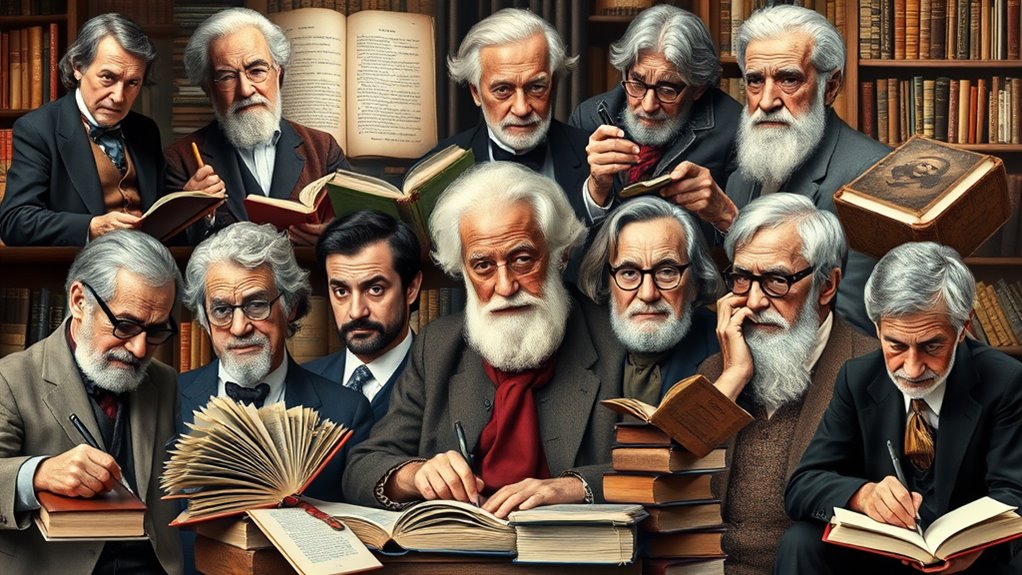
Exploring the world of prolific authors reveals an astonishing breadth of creativity and output.
You'll discover that some writers, like Corín Tellado and Maria Lopez, have surpassed 4,000 published works, primarily in romance. Their writing techniques, marked by rapid production and appealing narratives, have captivated millions, with Tellado alone selling between 600 million to a billion copies.
Then there's Ryoki Inoue, who, with over 1,100 books under 39 pseudonyms, showcases remarkable genre exploration. His ability to weave stories across various genres, all while balancing a medical career, is a demonstration of his versatility and dedication.
Enid Blyton and Barbara Cartland also stand out. Blyton's contributions to children's literature, along with adventure tales, have earned her sales exceeding 600 million. Additionally, Cartland's legacy is enhanced by her extensive output in the romance genre, achieving over 723 published works.
These prolific authors often employed unique writing techniques, including ghostwriting and collaborations. For example, Alexandre Dumas utilized a studio of young writers to enhance his output.
Ultimately, understanding the prolific nature of these authors isn't just about the sheer number of works; it's about their approach to writing and the genres they explore.
With the ability to produce high-quality content across diverse themes, they've left an indelible mark on literature, proving that creativity knows no bounds.
L. Ron Hubbard's Achievements
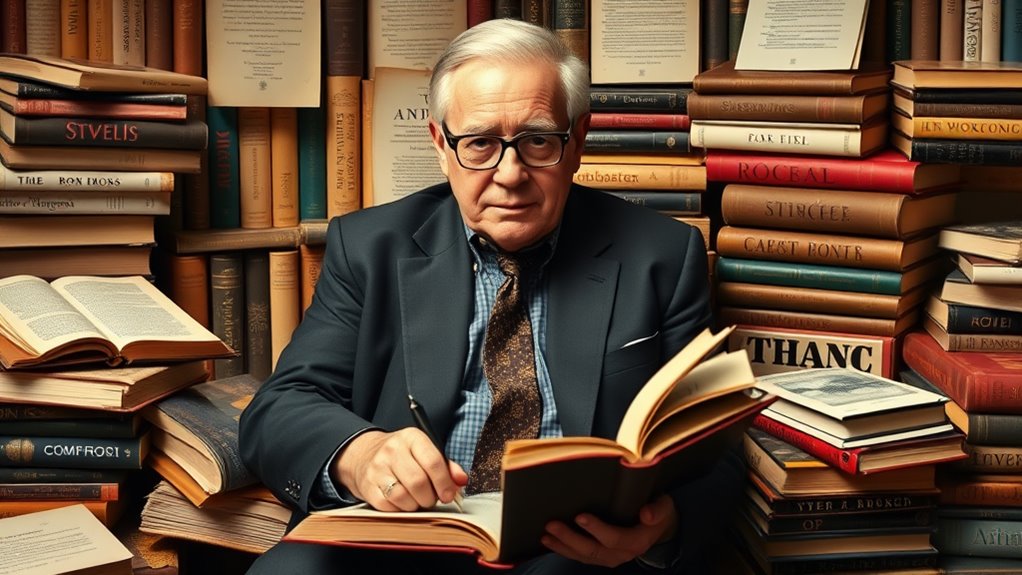
Producing an astonishing body of work, L. Ron Hubbard stands out as one of the most prolific authors in history. With over 1,000 published works, including more than 150 novels and novellas, his achievements are truly remarkable.
You'll find his genre diversity fascinating, as he wrote in science fiction, fantasy, mystery, and romance, among others. His notable works like *Dianetics*, *Battlefield Earth*, and the *Mission Earth* series showcase this breadth.
Hubbard's writing techniques contributed greatly to his prolific output. He achieved a peak writing rate of over 100,000 words a month, often using a special electric IBM typewriter that featured extra keys for common words. This allowed him to streamline his writing process and produce an impressive volume of content. In addition, his extensive research and dedication to his craft resulted in the creation of the largest body of information on mind, spirit, and life.
His literary impact is undeniable, with over 250 million copies of his works sold worldwide. He holds four Guinness World Records, including "Most Published Works by One Author" and "Most Translated Author in the World." His works have been translated into seventy-two languages, influencing science fiction and popular culture extensively.
Beyond writing, Hubbard established Author Services, Inc. to oversee his creative properties and initiated various contests to encourage new talent.
His innovative approach to audiobooks and live readings has inspired a dedicated following, ensuring his legacy continues to thrive in the literary world.
Corín Tellado's Remarkable Output

Throughout her illustrious career, Corín Tellado emerged as one of the most prolific authors in the Spanish-speaking world, publishing an astonishing 4,000 to 5,000 titles. She began writing at the young age of 19, and her commitment to her craft was astounding—delivering a short novel every week for a significant part of her career.
You'd be amazed to learn that she could complete a novel in just over two days, showcasing her remarkable writing techniques.
Tellado's novels often centered around contemporary settings, steering clear of historical contexts. This choice allowed her to connect with readers on a personal level, tackling pressing literary themes like women's rights, family abuse, and various social issues. Additionally, she published her most popular novel, "Luna oculta(most popular novel)," in 1991, further solidifying her reputation.
Her straightforward presentation of characters made it easy for readers to immerse themselves in the stories, while the endings typically culminated in weddings, offering a sense of hope despite the heartbreak and challenges addressed throughout her plots.
Her skillful blending of tough subjects with relatable storytelling not only resonated with her audience but also earned her a place in the 1994 Guinness World Records for selling the most books written in Spanish.
With over 400 million copies sold and translations into 27 languages, Tellado's impact on literature and culture remains significant. As you explore her legacy, you'll find that her incredible output continues to inspire writers and readers alike, solidifying her position as an iconic figure in modern literature.
Ryoki Inoue's Literary Contributions
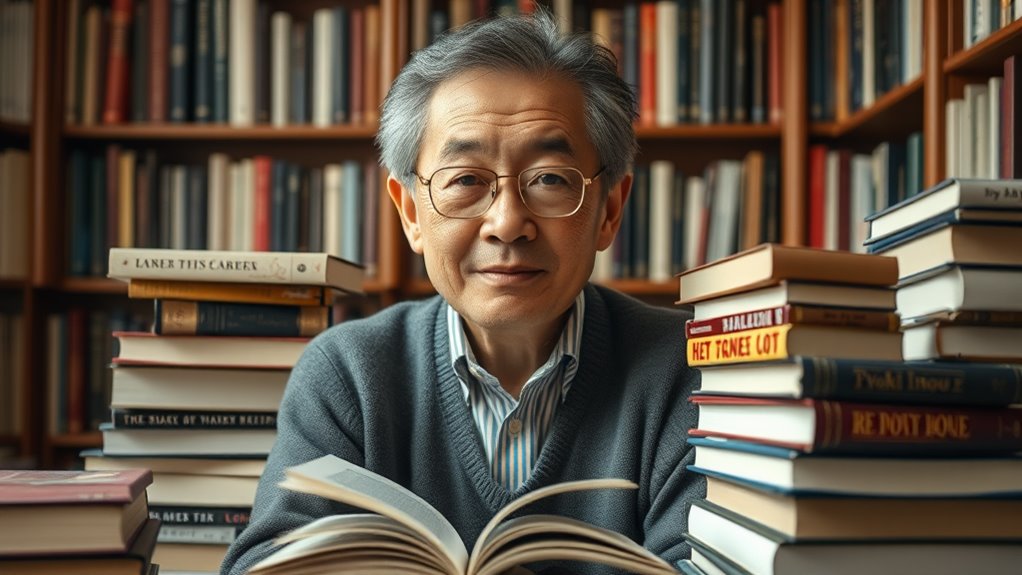
Corín Tellado's remarkable legacy in the literary world finds an intriguing counterpart in the prolific output of Ryoki Inoue. Born in São Paulo, Brazil, in 1946, Inoue shifted from a medical career to become one of the most published authors in history. Recognized by Guinness World Records in 1993, he published over 1,000 books by 1996, showcasing his exceptional writing discipline. His contributions to Brazilian literature have been widely recognized and reflect diverse themes.
Inoue's formula for success was unique. He developed a systematic approach that allowed him to write up to three books a day. This involved specific elements, such as a maximum of 20 characters, a minimum of five killings, and at least two romantic scenes. His style spanned various genres, including police plots, suspense, and love stories, often incorporating explosive plot devices like dynamite to enhance the narrative.
Despite his staggering output, Inoue faced criticism for the perceived quality of his work. Many believed that the sheer volume compromised literary merit. However, he argued that quantity doesn't necessarily detract from quality, a sentiment that resonates with many prolific writers.
His notable works, like "Saga: A Historia de Quatro Geracoes de Uma Familia Japonesa No Brasil," demonstrate his ability to produce both quantity and depth. Inoue's career, marked by minimal marketing efforts, underscores his passion for writing as a means of survival.
His contributions to literature, while sometimes overshadowed by skepticism, reflect a relentless commitment to storytelling.
Enid Blyton's Children's Classics
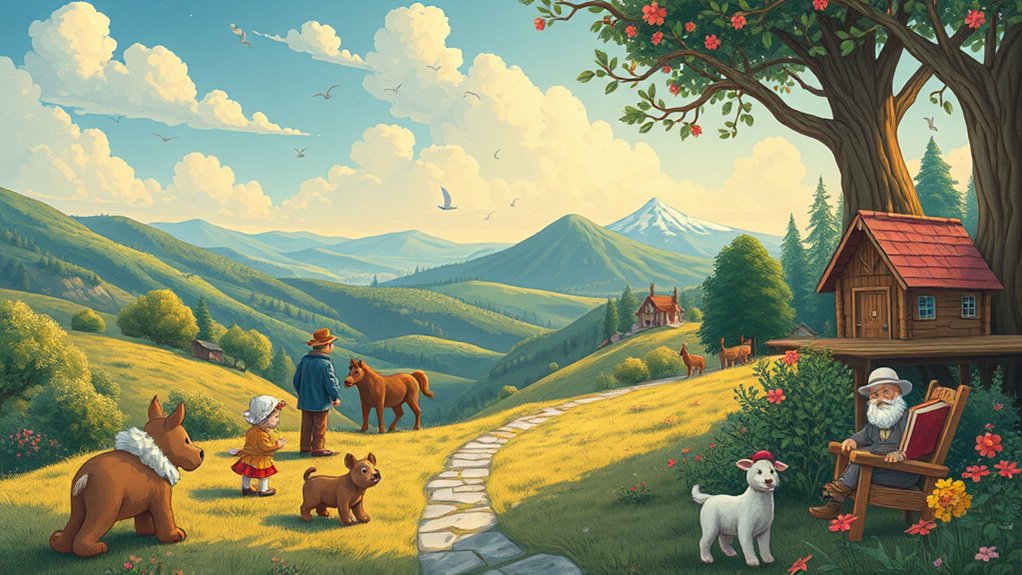
Enid Blyton's children's classics have enchanted generations of young readers, crafting a world where adventure and friendship reign supreme. With over 700 books and more than 10,000 short stories, her prolific body of work spans various genres, including fantasy, mystery, and education. You might recognize iconic series like *The Famous Five*, where Julian, Dick, Anne, George, and Timmy initiate timeless adventures, or *The Secret Seven*, a group of young detectives solving mysteries together.
Blyton's storytelling is characterized by its ability to foster a sense of wonder and camaraderie among young readers. Her characters often embody values like courage, resourcefulness, and compassion, making them relatable and inspiring. Whether you're delving into the magical world of *The Faraway Tree* or enjoying the antics of *Noddy*, you can't help but feel drawn into the excitement of her narratives. In fact, Blyton's prolific output established her as a leading figure in children's literature.
Despite selling over 600 million copies worldwide and having her work translated into ninety languages, Blyton's legacy isn't without controversy. Some of her views on race and class have drawn criticism, leading to edits in certain editions.
Nevertheless, her timeless adventures continue to resonate, with adaptations for television, film, and stage keeping her stories alive. In a world that constantly evolves, Blyton's charm remains, enchanting young imaginations and ensuring her place as one of the most beloved children's authors globally.
Barbara Cartland's Romance Novels

Few authors have made as significant an impact on the romance genre as Barbara Cartland, who penned an astounding 723 books during her lifetime, including 675 romantic novels. Her prolific output averaged 23 books per year starting in the mid-1970s, and she even set a Guinness World Record by writing 23 novels in a single year.
Cartland's enchanting settings, strong heroines, and dashing heroes captivated readers, whisking them away to glamorous ballrooms and exotic locations that epitomized romantic escapism.
While her enchanting tales often featured fairy-tale endings, they sometimes faced criticism for their formulaic plots. However, it's this very predictability that drew many fans to her work, offering a comforting familiarity in the often chaotic world of love.
Cartland's themes of love, honor, and chivalry resonated deeply, making her novels a staple in the romance genre. In addition to her commercial success, she was recognized for her contribution to literature with a Damehood in 1991.
Her influence can't be overstated; she sold over 1 billion copies in 35-38 languages by 2000, paving the way for future female authors in a male-dominated field.
Cartland set the standard for modern romance fiction, blending passion, intrigue, and fantasy while crafting complex characters and intricate plots.
Even well into her 90s, she continued to produce novels, often dictating to her secretary, showcasing her unwavering dedication to storytelling.
Today, her legacy endures, and she remains a beloved figure in the world of romantic fiction.
Isaac Asimov's Diverse Works
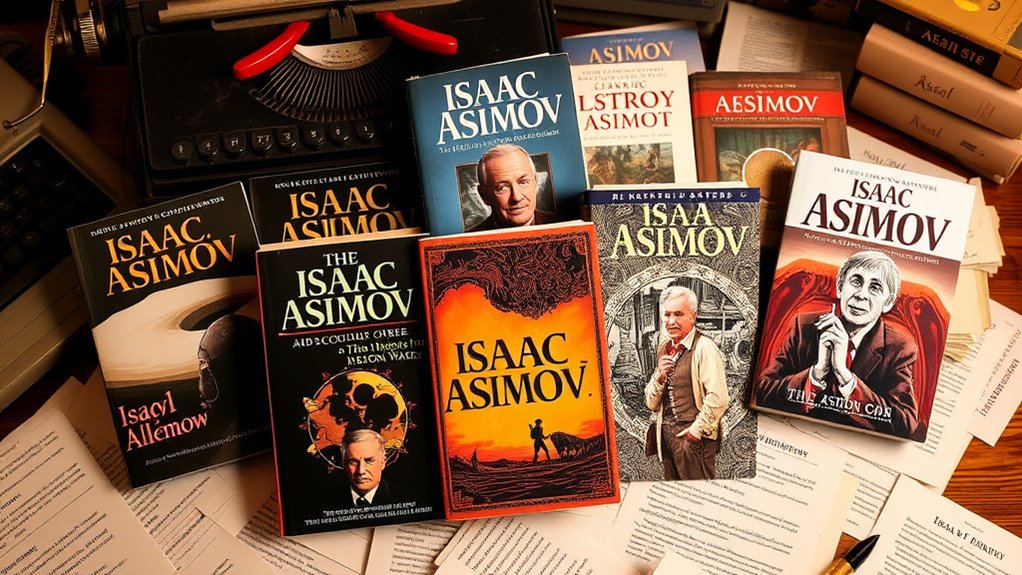
Isaac Asimov's vast body of work showcases his extraordinary versatility as an author, spanning science fiction, non-fiction, and educational literature. You'll find that Asimov's genres are remarkably diverse, ranging from the imaginative domains of science fiction to the rigorous frameworks of science and technology.
His iconic "I, Robot" collection explores robotics and artificial intelligence, while the "Foundation Series" presents a sweeping narrative about the rise and fall of civilizations. With works like "The Gods Themselves," he plunges into themes of parallel universes and energy, pushing the boundaries of human understanding.
In addition to his fiction, Asimov produced an impressive array of non-fiction works that explored various scientific fields. Titles such as "A Short History of Biology" and "Understanding Physics" reflect his commitment to making complex subjects accessible to readers.
His educational guides, like "Quick and Easy Math," further emphasize his dedication to enlightening minds. Asimov's themes often center around the intersection of humanity and technology, as well as the moral implications of scientific advancements.
He didn't just entertain; he challenged readers to think critically about the future. With over 500 published works, Asimov's impact is palpable, influencing generations of writers and scientists alike. His ability to traverse different genres and subjects truly sets him apart as one of the most prolific authors in literary history.
Measuring Prolific Output

Measuring prolific output in literature can be surprisingly complex, as it involves various criteria that can skew perceptions of an author's true productivity. Factors like publication count, genre, and the impact of ghostwriting ethics all play a role. For example, while L. Ron Hubbard holds the Guinness World Record with 1,084 published works, Corín Tellado's claim to fame lies in her extensive catalog of over 4,000 works when considering serialized pieces.
The publication evolution of writing has also affected how we assess prolific authors. Here's a quick look at some notable figures:
| Author | Total Works | Notable Contributions |
|---|---|---|
| L. Ron Hubbard | 1,084 | Over 250 fiction titles |
| Corín Tellado | 4,000+ | Renowned romance novelist |
| Barbara Cartland | 723 | Prolific in the romance genre |
| Enid Blyton | ~800 | Famous children's literature |
| Isaac Asimov | ~500 | Science fiction and popular science |
Additionally, some authors collaborate or use ghostwriters, complicating their total output. While this practice can inflate publication numbers, it raises questions about ghostwriting ethics. Furthermore, variations in how works are counted—like translations or editions—further complicate the metrics. Ultimately, understanding prolific output requires maneuvering these complexities and recognizing that quantity doesn't always equate to literary quality.
Sales and Impact of Authors
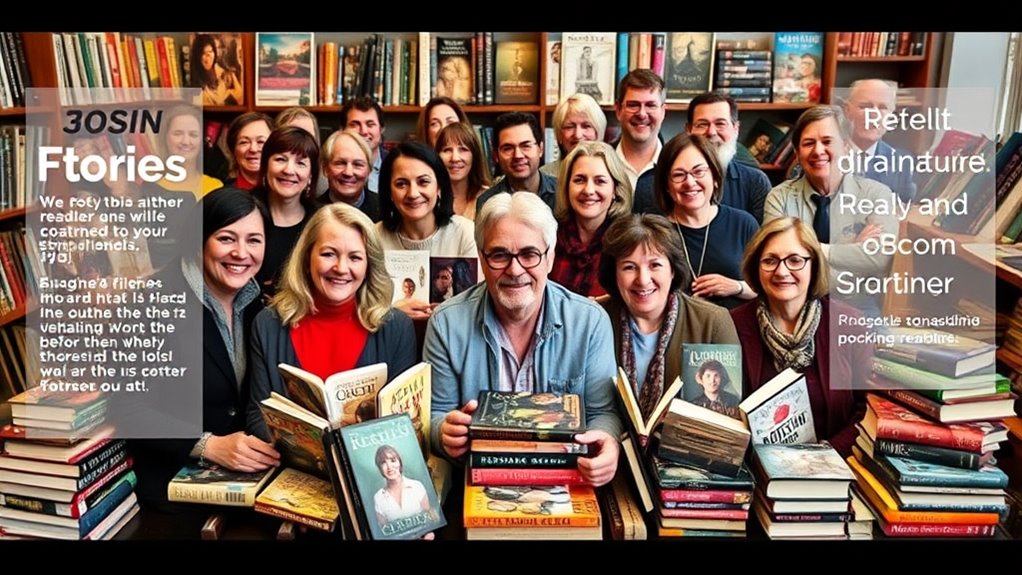
While many authors have made their mark through sheer volume, the sales figures and cultural impact of their works reveal a deeper story about their influence on literature and society. You'll find that the numbers speak volumes about author sales and their lasting literary impact.
- Corín Tellado: With estimated sales between 600 million and 1 billion, her romance novels have shaped the genre across generations.
- Enid Blyton: Her works, selling over 600 million copies, continue to capture children's imaginations and are essential in children's literature studies.
- Barbara Cartland: Known for her prolific output, Cartland's sales range from 500 million to 750 million, establishing her as a prominent figure in romance writing.
These authors didn't just sell books; they created cultural phenomena. Mark Twain's influence resonates through American literature, inspiring countless writers.
Similarly, Dr. Seuss and Roald Dahl have left indelible marks on children's literature, with Dr. Seuss's works selling over 700 million copies and inspiring numerous adaptations.
It's not just about the quantity of books written but also how these authors have shaped literary trends and societal norms.
With significant earnings and cultural relevance, these prolific writers showcase how author sales can reflect a deeper engagement with readers and the world. Their works remain timeless, proving that the impact of literature extends far beyond the pages of a book.
Comparison With Other Best-Sellers
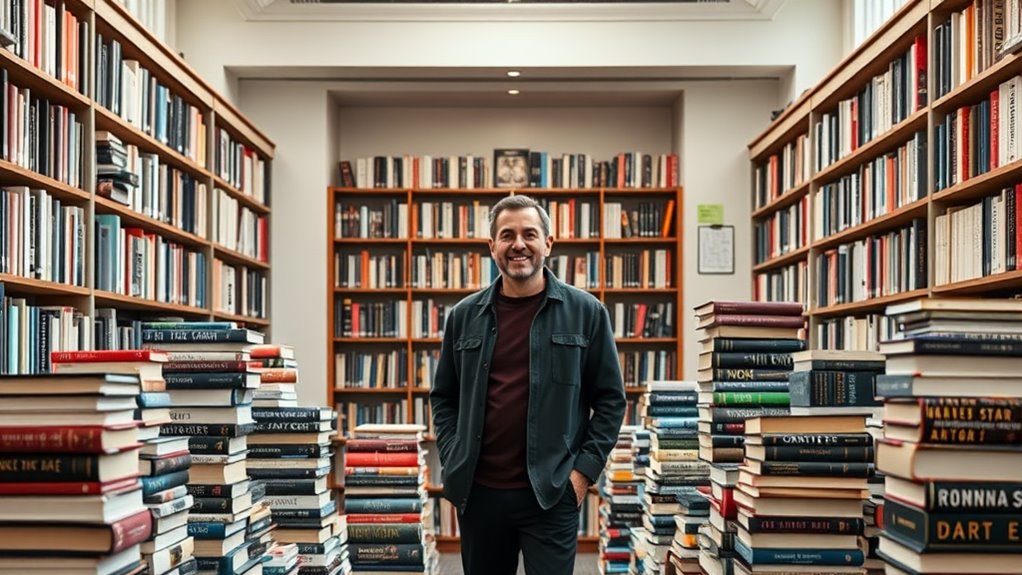
When comparing prolific authors, it's fascinating to see how their sheer output and sales figures vary dramatically.
Take L. Ron Hubbard, for instance, who published 1,084 works and holds the Guinness World Record for the most prolific writer. In stark contrast, Corín Tellado released over 4,000 works, mainly in Spanish romance, boasting sales figures between 600 million and 1 billion copies. These bestseller comparisons highlight significant genre diversity, with Hubbard exploring science fiction and Tellado specializing in romance.
Ryoki Inoue, with approximately 1,075 works, ranks highly in productivity, though he's less recognized globally. Meanwhile, Enid Blyton, known for children's literature, published around 800 works and achieved sales exceeding 600 million copies, especially with her "Famous Five" series.
Barbara Cartland, another romance author, published around 723 works, achieving 500 to 750 million sales.
Authors like Isaac Asimov and R.L. Stine, while not as prolific regarding sheer volume, have made their marks in other ways. Asimov's 500 works spanned science fiction and non-fiction, whereas Stine's 450 works in children's horror, particularly the "Goosebumps" series, have sold over 400 million copies.
Georges Simenon, with 570 works, also made a notable impact in detective fiction.
These comparisons illustrate the vast landscape of authorship, showcasing how genre diversity influences both productivity and sales in the literary world.
Cultural Influence of Prolific Writers
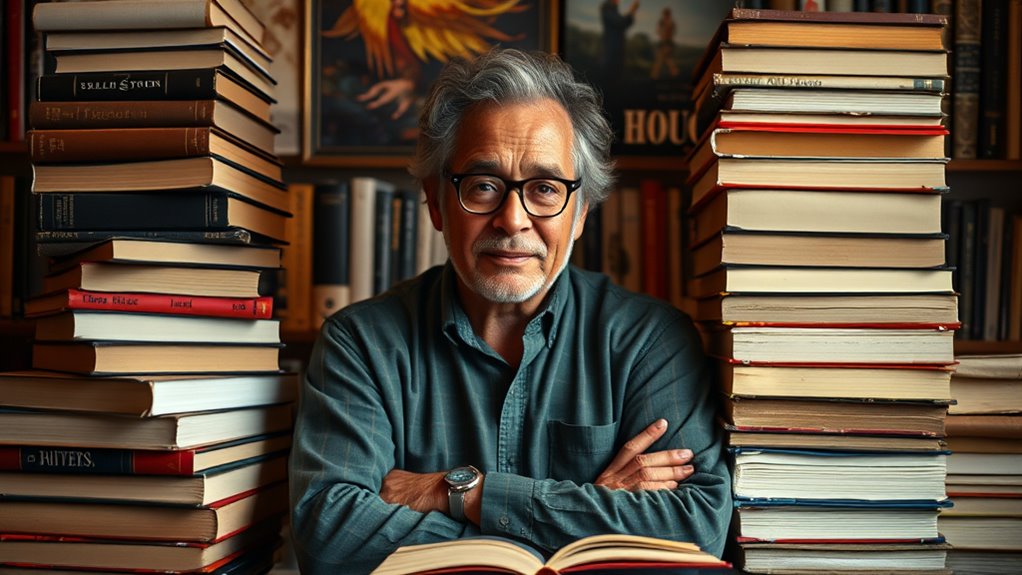
Cultural influence permeates the literary landscape, showcasing how prolific writers shape genres, spark conversations, and inspire future generations.
These writers don't just produce volumes of work; they create a cultural legacy that resonates through time. Their books often tackle pressing social issues, offering perspectives that challenge readers and encourage dialogue.
Here are three key ways prolific writers exert their cultural influence:
- Influence on Genres: Writers like Corín Tellado and Enid Blyton have defined the romance and children's genres, respectively. Their extensive catalogs set standards and inspire aspiring authors.
- Social and Historical Context: Authors such as Toni Morrison and Richard Wright have reshaped literature by addressing complex themes like race and identity. Their work has sparked meaningful conversations about society, making literature a powerful tool for change.
- Literary Mentorship: The impact of prolific writers extends beyond their own works. Figures like Richard Wright and Toni Morrison have mentored emerging writers, fostering new voices in literature. This literary mentorship guarantees the continuity of diverse narratives, enriching the literary community.
Through these avenues, prolific writers leave an indelible mark on culture. Their contributions influence not just what you read today, but how future generations will approach storytelling, social issues, and the very act of writing itself.
Frequently Asked Questions
What Criteria Define a "Published Work" for Authors?
When defining a "published work," you should consider book-length criteria, which typically include novels and non-fiction books, but exclude shorter pieces unless they're compiled.
Self-publishing trends have made it easier for authors to get their works out, while academic publications often require rigorous standards.
You'll find that substantial contributions to the content and final approval are essential for authorship, regardless of the publishing route you choose.
How Do Ghostwriters Affect an Author's Book Count?
In this modern age of literature, ghostwriters greatly boost an author's book count. They streamline the writing process, allowing you to publish more frequently.
However, ghostwriting ethics come into play; maintaining authorship authenticity is vital. By collaborating closely, ghostwriters can guarantee your voice remains intact while enhancing the book's quality.
This partnership not only increases your output but also enriches the overall literary landscape, offering readers diverse and engaging content.
Which Genres Are Most Represented Among Prolific Authors?
When you look at prolific authors, you'll notice a fascinating genre diversity.
Romance tops the list, with authors like Corín Tellado leading the charge.
You'll also find significant contributions in science fiction from L. Ron Hubbard and children's literature by Enid Blyton.
These prolific trends highlight how different genres attract dedicated writers, often leading to astonishing publication counts and widespread popularity within their respective fields.
It's truly impressive!
How Is the Cultural Impact of Authors Measured?
You might think measuring an author's cultural impact is as simple as counting books sold, but it's much deeper.
It involves examining their literary legacy and the cultural significance of their themes. Authors challenge societal norms, spark conversations, and influence movements. Their works resonate in classrooms, book clubs, and beyond, shaping how society views race, gender, and identity.
What Role Do Translations Play in an Author's Sales Figures?
Translations play a vital role in an author's sales figures by expanding their reach and boosting sales metrics.
When you translate a book, it often leads to a significant increase in readership, as it breaks language barriers.
This translation impact can revitalize lesser-known works and bring them to new audiences.
As a result, authors can enjoy heightened recognition and increased revenue, benefiting from the global literary market's diversity.
